|
|
 |
|
Harpacticoida ( Order ) |
|
|
|
Ectinosomatidae ( Family ) |
|
|
|
Microsetella ( Genus ) |
|
|
| |
Microsetella norvegica (Boeck, 1864) (F,M) | |
| | | | | | | Syn.: | Setella norvegica Boeck, 1864;
Microsetella atlantica Brady & Robertson, 1873 (p.130, figs.F); Giesbrecht, 1892 (p.550, 554, figs.F,M); Vanhöffen, 1897 a (p.281); Mrazek, 1902 (p.518); Chatton, 1920 (p.17); Rose, 1926 h (p.251); Mori, 1929 (p.200, figs.6-7); Halim, 1969 (tab. XXIV); Dorgham & al., 2012 (p.473, Table 3: abundance %);
Ectinosoma atlanticum Brady & Robertso, 1873 (p.11, Figs.F); Brady, 1880 (p.130, figs.F); 1883 (p.100, figs.F); Thompson & Scott, 1903 (p.237, 257); Wolfenden, 1911 (p.364); de Guerne, 1938 (p.14, figs.F,M);
Microsetella brevifida Giesbrecht, 1891 | | | | Ref.: | | | Sars, 1904 a (1911) (p.44, figs.F,M); A. Scott, 1909 (p.199, Rem.); Lysholm, 1913 (p.8); Pesta, 1920 (p.566); Sewell, 1924 (p.809); Früchtl, 1924 b (p.103); Farran, 1926 (p.299); 1929 (p.211, 297); Wilson, 1932 a (p.176, figs.F,M); Rose, 1933 a (p.287, figs.F,M); Sewell, 1933 (p.30); Farran, 1936 a (p.123); Mori, 1937 (1964) (p.116, figs.F); Jespersen, 1940 (p.73); Sewell, 1940 (p.140); Klie, 1943 a (n°4, p.3, figs.F, Rem.F,M); Lysholm & al., 1945 (p.44); Sewell, 1947 (p.289); Lang, 1948 a (p.230, figs.F,M); Davis, 1949 (p.70, figs.F); Carvalho, 1952 a (p.155, figs.F); Shen & Bai, 1956 (p.229, figs.F); Marques, 1958 a (p.143); Tanaka, 1960 (p.91); Gonzalez & Bowman, 1965 (p.265, figs.F); Owre & Foyo, 1967 (p.104, figs.F,M); Ramirez, 1969 (p.97, figs.F); Minoda, 1971 (p.48); Shih & al., 1971 (p.51,154, 210); Kos, 1972 (Vol.I, figs.F,M, Rem.); Razouls, 1972 (p.140); Chen & al., 1974 (p.67, figs.F,M); Boxshall, 1979 (p.207, figs.F,M); Dawson & Knatz, 1980 (p.10, figs.F,M); Gardner & Szabo, 1982 (p.76, figs.F,M); Chen & al., 1974 (p.67, figs.F,M); Shih & Laubitz, 1978 (p.50); Björnberg & al., 1981 (p.677, figs.F,M); Diaz & Evans, 1983 (p.113, figs.N, Juv., F,M, Rem.); Zheng Zhong & al., 1984 (1989) (p.268, figs.F,M); Kim & al., 1993 (p.271); Chihara & Murano, 1997 (p.955, Pl.207: F,M); Bradford-Grieve & al., 1999 (p.886, 969, figs.F,M); Conway & al., 2003 (p.213, figs.F,M, Rem.); Conway, 2006 (p.24, copepodides 1-6, Rem.); Avancini & al., 2006 (p.128, Pl. 96, figs.F,M, Rem.); Vives & Shmeleva, 2010 (p.102, figs.F,M, Rem.) |  issued from : F.C. Ramirez in Contr. Inst. Biol. mar., Buenos Aires, 1969, 98. [p.98, Lam. XX, figs. 172, 173]. Female (from off Mar del Plata): 172, habitus (lateral left side); 173, P5. Scale bars in mm: 0.2 (172); 0.05 (173).
|
 issued from : Q.-c Chen & S.-z. Zhang & C.-s. Zhu in Studia Marina Sinica, 1974, 9. [Pl.23, Figs.11-14]. Female (from China Seas): 11, habitus (lateral left side); 12, P5. Male: 13, habitus (dorsal); 14, P5.
|
 issued from : C.-j. Shen & S.-o. Bai in Acta Zool. sin., 1956, 8 (2). [Pl.IX, Figs.70-73]. Female (from Chefoo): 70, habitus (dorsal); 71, A1; 72, A2; 73, P5. Nota: The specimen is similar to the European form, except that the spine on the surface of the 2nd segment of P5 is relatively longer than that as illustrated by Sars (1904) and Mori (1937), but it agrees with the Giesbrecht's (1929) figure.
|
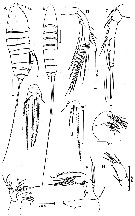 issued from : G.A. Boxshall in Bull. Br. Mus. nat. Hist. (Zool.), 1979, 35 (3). [p.208, Fig.2, A-J]. Female (from 18°N, 25°W): A-B, habitus (lateral and dorsal, respectively); C, A1; D, A2; E, Md; F, Mx1; G, Mx2; H, Mxp; I, P5. Male: J, P5. Scales 0.1 mm unless otherwise indicated.
|
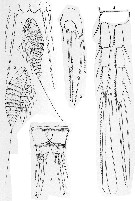 issued from : J. de Guerne in Res. Camp. Scient. Prince Albert Ier Movaco, 1938 (97). [Pl. II, Fig.1-6]. As Ectinosoma atlanticum. Female (from 51°-53°N, 11°-15°W): 2, habitus (lateral); 3, anal segment and caudal rami (ventral); 4, left P3; 6, right P5. Male: 1, habitus (lateral); 5, P5.
|
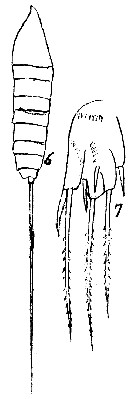 issued from : T. Mori in Zool. Mag. Tokyo, 1929, 41 (486-487). [Pl. VIII, Figs. 6-7)]. As Microsetella atlantica. Female (from Chosen Strait, Korea-Japan): 6, habitus (lateral); 7, P5.
|
 issued from : T. Mori in The Pelagic copepoda from the neighbouring waters of Japan, 1937 (1964). [Pl. 64, Figs.9-10]. Female: 9, P5; 10, habitus (lateral).
|
 Issued from : W. Giesbrecht in Systematik und Faunistik der Pelagischen Copepoden des Golfes von Neapel und der angrenzenden Meeres-Abschnitte. – Fauna Flora Golf. Neapel, 1892, 19 , Atlas von 54 Tafeln. [Taf.44, Fig.39]. As Microsetella atlantica var. Female: 39, habitus (lateral).
|
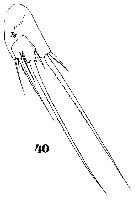 Issued from : W. Giesbrecht in Systematik und Faunistik der Pelagischen Copepoden des Golfes von Neapel und der angrenzenden Meeres-Abschnitte. – Fauna Flora Golf. Neapel, 1892, 19 , Atlas von 54 Tafeln. [Taf.44, Fig.40]. As Microsetella atlantica var. Female: 40, P5.
|
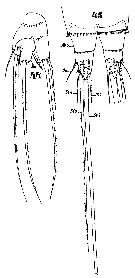 Issued from : W. Giesbrecht in Systematik und Faunistik der Pelagischen Copepoden des Golfes von Neapel und der angrenzenden Meeres-Abschnitte. – Fauna Flora Golf. Neapel, 1892, 19 , Atlas von 54 Tafeln. [Taf.44, Figs.44, 45]. As Microsetella atlantica. Female: 44, P5; 45, anal segment and caudal rami (ventral).
|
 Issued from : W. Giesbrecht in Systematik und Faunistik der Pelagischen Copepoden des Golfes von Neapel und der angrenzenden Meeres-Abschnitte. – Fauna Flora Golf. Neapel, 1892, 19 , Atlas von 54 Tafeln. [Taf.44, Fig.34]. As Microsetella atlantica. Female: 34, A2.
|
 Issued from : W. Giesbrecht in Systematik und Faunistik der Pelagischen Copepoden des Golfes von Neapel und der angrenzenden Meeres-Abschnitte. – Fauna Flora Golf. Neapel, 1892, 19 , Atlas von 54 Tafeln. [Taf.44, Fig.42]. As Microsetella atlantica. Male: 42, habitus (lateral).
|
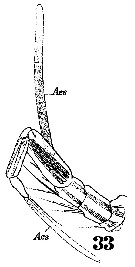 Issued from : W. Giesbrecht in Systematik und Faunistik der Pelagischen Copepoden des Golfes von Neapel und der angrenzenden Meeres-Abschnitte. – Fauna Flora Golf. Neapel, 1892, 19 , Atlas von 54 Tafeln. [Taf.44, Fig.33]. As Microsetella atlantica. Male: 33, A1. Ae = aesthetasc.
|
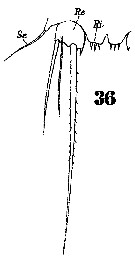 Issued from : W. Giesbrecht in Systematik und Faunistik der Pelagischen Copepoden des Golfes von Neapel und der angrenzenden Meeres-Abschnitte. – Fauna Flora Golf. Neapel, 1892, 19 , Atlas von 54 Tafeln. [Taf.44, Fig.36]. As Microsetella atlantica. Male: 36, P5. St = terminal setae; Se = outer seta.
|
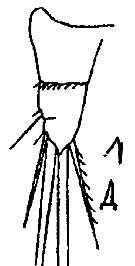 Issued from : M.S. Kos in Field guide for plankton. Zool Institute USSR Acad., Vol. I, 1972. After G.O. Sars, 1911. Female: 1, caudal ramus.
| | | | | Compl. Ref.: | | | Sars, 1909 b (p.18); Rose, 1925 (p.152); Gurney, 1927 (p.167); Wilson, 1932 (p.38); Hardy & Gunther, 1935 (1936) (p.189, Rem.); Jespersen, 1939 (p.73, Rem.); Wilson, 1942 a (p.194); Massuti Alzamora, 1942 (p.108, Rem.); Sewell, 1948 (p.394, 488, 493, 506, 515); C.B. Wilson, 1950 (p.266); Fleury, 1950 (p.47, fig.2); Fish, 1955 (p.242); Østvedt, 1955 (p.15: Table 3, p.79); Deevey, 1956 (p.127, tab. IV); Yamazi, 1958 (p.154, Rem.); Minoda, 1958 (p.253, Table 1,2, abundance); Fagetti, 1962 (p.40); Grice & Hart, 1962 (p.287, 295: Rem.); Ganapati & Shanthakumari, 1962 (p.11, 16); Giron-Reguer, 1963 (p.56); V.N. Greze, 1963 a (tabl.2); Gaudy, 1963 (p.30, Rem.); Björnberg, 1963 (p.67); De Decker, 1964 (p.16, 22, 30); De Decker & Mombeck, 1964 (p.13); Martin, 1965 (p.188); Neto & Paiva, 1966 (p.35, Table III); Mazza, 1966 (p.73); Ehrhardt, 1967 (p.742, geographic distribution, Rem.); Delalo, 1968 (p.138); Vinogradov, 1968 (1970) (p.268); Dowidar & El-Maghraby, 1970 (p.268); Bainbridge, 1972 (p.61, Appendix Table I: vertical distribution vs day/night); Apostolopoulou, 1972 (p.329, 374); Björnberg, 1973 (p.370, 387); Arndt & Heidecke, 1973 (p.599, 603); Hirota, 1974 (p.1, Table 3, 4, fig.4, 5, 6); Corral Estrada & Pereiro Muñoz, 1974 (tab.I); Kolosova, 1975 (p.92, fig.3, Table 1); Anraku, 1975 (p.79, microdistribution); Hirota & Hara, 1975 (p.115, fig.5); Patel, 1975 (p.660); Vives & al., 1975 (p.54, tab.II, III, IV); Davis C.C., 1976 (p.37, fig.2, reproductive characteristics); Hanaoka, 1977 (p.267, 300, abundance); Madhu Pratap & al., 1977 (p.138, Table 3: abundance vs. stations); Evans & Diaz, 1978 (p.313, body size-temperature); Hirota, 1979 a (p.33, Table 2, fig.5); Chen Q-c, 1980 (p.795); Vaissière & Séguin, 1980 (p.23, tab.1); Pipe & Coombs, 1980 (p.223, vertical occurrence); Sreekumaran Nair & al., 1981 (p.493), Hirota 1981 (p.19, Table 1, length-weight-CHN); Vives, 1982 (p.295); Kovalev & Shmeleva, 1982 (p.85); Turner & Dagg, 1983 (p.17, 22); Guangshan & Honglin, 1984 (p.118, tab.); De Decker, 1984 (p.317, 355: chart); Dugas & Koslow, 1984 (p.131); Scotto di Carlo & al., 1984 (p.1043); Tremblay & Anderson, 1984 (p.8, Rem.); Regner, 1985 (p.11, Rem.: p.40); Garcia-Rodriguez, 1985 (p.37); Diouf & Diallo, 1987 (p.260); Jimenez-Perez & Lara-Lara, 1988 (p.126); Lozano Soldevilla & al., 1988 (p.61); Krsinic & Vilicic, 1989 (p.12, tab.3); Citarella, 1989 (p.123, abundance); Kosobokova, 1989 (p.26); Coyle & al., 1990 (p.763); Hirakawa & al., 1990 (tab.3); Dai & al., 1991 (tab.1); Yoo, 1991 (tab.1); McKinnon, 1991 (p.471); Norrbin, 1992 (p.5, 6); Ayukai & Hattori, 1992 (p.163, Rem.: p.170, fecal pellets); Seguin & al., 1993 (p.23); Richter, 1994 (tab.4.1a); Vinogradov & al., 1994 (tab.1); Uye & Kaname, 1994 (p.43, length v.s. fecal pellet volume); Shih & Young, 1995 (p.75); Böttger-Schnack, 1995 (p.93); Santos & Ramirez, 1995 (p.133, fig.2); Webber & Roff, 1995 (tab.1); Krause & al., 1995 (p.81, Fig.24, abundance, Rem.: p.135); Fernandez de Puelles & al., 1996 (p.97, occurrence: p.101); Kotani & al., 1996 (tab.2); Errhif & al., 1997 (p.422); Park & Choi, 1997 (Appendix); Noda & al., 1998 (p.55, Table 3, occurrence); Hure & Krsinic, 1998 (p.80, 103); Padmavati & al., 1998 (p.349); ? Hopcroft & al., 1998 (tab.2); Gilabert & Moreno, 1998 (tab.1, 2); Schnack-Schiel & al., 1998 (p.173, abundance, sea ice); Kosobokova & al., 1998 (tab.2); Suarez-Morales & Gasca, 1998 a (p.113); Abramova, 1999 (p.161, Table 2); Neumann-Leitao & al., 1999 (p.153, tab.2); Siokou-Frangou, 1999 (p.478); Harvey & al., 1999 (p.1, 49: Appendix 5, in ballast water vessel); Razouls & al., 2000 (p.343, Appendix); El-Sherif & Aboul Ezz, 2000 (p.61, Table 3: occurrence); Ueda & al., 2000 (tab.1); Fernandez-Alamo & al., 2000 (p.1139, Appendix); Suarez-Morales & al., 2000 (p.751, tab.1); d'Elbée, 2001 (tabl.1); Kosobokova & Hirche, 2000 (p.2029, tab.2); Musaeva & Gagarin, 2000 (p.534, tab.1); Musaeva & Suntsov, 2001 (p.511); Uysal & al. (comm. pers. 2001); Richard & Jamet, 2001 (p.959); Fransz & Gonzalez, 2001 (p.255, tab.1); El-Serehy & al., 2001 (p.116, Table 1: abundance vs transect in Suez Canal); Hidalgo & Escribano, 2001 (p.159, tab.2); Hidalgo & Escribano, 2001 (p.157, fig.4); Sameoto & al., 2002 (p.13); Zerouali & Melhaoui, 2002 (p.91, Tableau I); Kosobokova & al., 2003 (p.697, tab.2); Vukanic, 2003 (p.139, tab.1); Rezai & al., 2004 (p.486, tab.2, 3, abundance, Rem., p.495, tab.8); Daly Yahia & al., 2004 (p.366, fig.4); Lan & al., 2004 (p.332, tab.1); Gislason & Astthorsson, 2004 (p.472, tab.1); Gallienne & al., 2004 (p.5, tab.3); Kazmi, 2004 (p.230); Hopcroft & al., 2005 (p.198, table 2); Choi & al., 2005 (p.710: Tab.III); Manning & Bucklin, 2005 (p.233, Table 1); Obuid Allah & al., 2005 (p.123, occurrence % vs metal contamination); Zuo & al., 2006 (p.159, tab.1, abundance, fig.8: stations group); Blachowiak-Samolyk & al., 2006 (p.101, tab.1); Durbin & Casas, 2006 (p.2537, Table 2a, 2b); Mageed, 2006 (p.171, Table 4); Hop & al., 2006 (p.182, Table 4); Sterza & Fernades, 2006 (p.95, Table 1, occurrence); Deibel & Daly; 2007 (p.271, Table 4, Rem.: Arctic polynyas); Ferrari & Dahms, 2007 (p.64, Rem.); Blachowiak-Samolyk & al., 2007 (p.2716, Table 2); Koski & al., 2007 (p.641, nutrition); Zakaria & al., 2007 (p.52, Table 1, vs Salinity); Khelifi-Touhami & al., 2007 (p.327, Table 1); Cabal & al., 2008 (289, Table 1); Humphrey, 2008 (p.85: Appendix A); Neumann-Leitao & al., 2008 (p.799: Tab.II, fig.6); Gaard & al., 2008 (p.59, Table1, N Atlantic Mid-Ridge); Rakhesh & al., 2008 (p.154, abundance vs stations); Blachowiak-Samolyk & al., 2008 (p.2210, Table 3, 5, biomass, composition vs climatic regimes); Ohtsuka & al., 2008 (p.115, Table 4, 5, Rem.: in Japan Harbors); Tseng L.-C. & al., 2008 (p.153, fig.5, Table 2, occurrence vs geographic distribution, indicator species); Galbraith, 2009 (pers. comm.); Miyashita & al., 2009 (p.815, Tabl.II); Norrbin & al., 2009 (p.1945, Table 4, 5, abundance); Dvoretsky & Dvoretsky, 2009 a (p.11, Table 2, abundance); C.E. Morales & al., 2010 (p.158, Table 1); Drira & al., 2010 (p.145, Tanl.2); Kosobokova & Hopcroft, 2010 (p.96, Table 1); Hernandez-Trujillo & al., 2010 (p.913, Table 2); Hidalgo & al., 2010 (p.2089, , fig.4, Table 2, cluster analysis); Thompson G.A. & al., 2011 (Table 2, 3, fig. 5); Hopcroft & al., 2010 (p.27, Table 1, 2, fig.9); Dias & al., 2010 (p.230, Table 1); Mazzocchi & Di Capua, 2010 (p.430); Medellin-Mora & Navas S., 2010 (p.265, Tab. 2); Dvoretsky & Dvoretsky, 2010 (p.991, Table 2); 2011 a (p.1231, Table 2; abundance, biomass); Kosobokova & al., 2011 (p.29, Table 2, fig.4, Rem.: Arctic Basins); Hirche & Kosobokova, 2011 (p.2359, Table 3, abundance, biomass %); Hsiao S.H. & al., 2011 (p.475, Appendix I); Arendt, 2011 (p.1, Rem. p.21, Fig.9: composition & biomass %); Arendt & al., 2011 (p.70, annual abundance & biomass); Hsiao & al., 2011 (p.317, Table 2, indicator of seasonal change); Tseng L.-C. & al., 2011 (p.47, Table 2, occurrences vs mesh sizes); Pepin & al., 2011 (p.273, Table 2, seasonal abundance); Ward & al., 2012 (p.78, Table A1, B1); Maiphae & Sa-ardrit, 2011 (p.641, Table 2, 3, Rem.); Saitoh & al., 2011 (p.85, Table 4, 5); Turner & al., 2011 (p.1066, Table II, abundance 1998-2008); S.C. Marques & al., 2011 (p.59, Table 1); Chew & Chong, 2011 (p.127, Table 3, abundance vs location); El-Sherbiny & al., 2011 (p.837, seasonal abundance), Beltrao & al., 2011 (p.47, Table 1, 2, 3, fig.3, density vs time); Uysal & Shmeleva, 2012 (p.909, Table I); Thompson G.A. & al., 2012 (p.127, Table 2, 3, fig.5); Thompson G. & al., 2012 (p.367, Rem.: p.377); DiBacco & al., 2012 (p.483, Table S1, ballast water transport); Salah S. & al., 2012 (p.155, Tableau 1); Johan & al., 2012 (2013) (p.1, Table 1); Ward & al., 2012 (p.78, Table A1, B1, abundance, weight); Dvoretsky & Dvoretsky, 2012 (p.1321, Table 2, 3, 4, 5, abundance, biomass, production); Jean & al., 2012 (p.12, Table 3, protein vs environmental metal stress); Johan & al., 2012 (p.647, Table 1, 2, fig.2, salinity range); Rekik & al., 2012 (p.336, Table 1, abundabce); Jose & al., 2012 (p.20, fig.3 a, b, c: % vs monsoon); Krsinic & Grbec, 2012 (p.57, 64: abundance); Aguirre & al., 2012 (p.341, Table I: abundance vs season); Hidalgo & al., 2012 (p.134, Table 2); Palomares-Garcia & al., 2013 (p.1009, Table I, abundance vs environmental factors); in CalCOFI regional list (MDO, Nov. 2013; M. Ohman, comm. pers.); Tachibana & al., 2013 (p.545, Table 1, seasonal change); Jagadeesan & al., 2013 (p.27, Table 3, seasonal variation); Tseng & al., 2013 a (p.1, Table 3, 5, abundance); LEl-Serehy & al., 2013 (p.2099, Rem.: p.2101); idvanov & al., 2013 (p.290, Table 2, % composition); Dvoretsky & Dvoretsky, 2013 a (p.205, Table 2, % abundance); Arendt & al., 2013 (p.105, fig.3, 7, abundance 2006-2010); Hwang & al., 2014 (p.43, Appendix A: seasonal abundance); Fierro Gonzalvez, 2014 (p.1, Tab. 3, 4, 5, occurrence, abundance); Zaafa & al., 2014 (p.67, Table I, occurrence); Antacli & al., 2014 (p.17, occurrence vs community structure); Nakajima & al., 2015 (p.19, Table 3: abundance); Zakaria & al., 2016 (p.1, Table 1, 3, 4) ; Benedetti & al., 2016 (p.159, Table I, fig.1, functional characters); Ben Ltaief & al., 2017 (p.1, Table III, Summer relative abundance); El Arraj & al., 2017 (p.272, table 2, spatial distribution); Marques-Rojas & Zoppi de Roa, 2017 (p.495, Table 1); Ohtsuka & Nishida, 2017 (p.565, Table 22.1, 578, Fig.22.3: outermost station in Japanese waters); Abo-Taleb & Gharib, 2018 (p.139, Table 5, p.146, occurrence %); Benedetti & al., 2018 (p.1, Fig.2: ecological functional group); Palomares-Garcia & al., 2018 (p.178, Table 1: occurrence); Acha & al., 2020 (p.1, Table 3: occurrence % vs ecoregions). | | | | NZ: | 25 | | |
|
Distribution map of Microsetella norvegica by geographical zones
|
| | | | | | | | | | | | | | | | | |  issued from : P. Jespersen, 1939 in Meddr Grønland, 1939, 119 (9). [p.74, Fig. 32]. issued from : P. Jespersen, 1939 in Meddr Grønland, 1939, 119 (9). [p.74, Fig. 32].
The occurrence of Microsetella norvegica at the ''Dana'' stations 1932-1933.
black circles: positive occurrence, vry abundant; white circle: rare or very rare; x: negative occurrence. |
 Issued from : M. Anraku in Mar. Biol., 1975, 30. [p.82, Figs. 1, 2]. Issued from : M. Anraku in Mar. Biol., 1975, 30. [p.82, Figs. 1, 2].
Distribution of hydrological factors and abundance of Microsetella norvegica in Oshoro Bay (west Hokkaido, Japan), 30 August 1958, along vertical section from stations 1 to 5 (distance 650 m).
Nota: The plankton samples were collected by means of a plankton pump during the morning hours at the same time as the hydrological observations. Copepodids and adults were counted ans expressed as number of individuals per 20 l.
The distribution of copepods in a limited area seems to be related to the pattern of oceanographic conditions to some extent, but a pattern of contagious distribution is also apparent. See Barnes & Marshall (1951) ; Cassie (1959) ; Boyd (1973). |
 Issued from : M. Anraku in Mar. Biol., 1975, 30. [p.84, Fig.5]. Issued from : M. Anraku in Mar. Biol., 1975, 30. [p.84, Fig.5].
Microdistribution of Microsetella norvegica in Oshoro Bay (west Hokkaido, Japan), 28 August 1958, ascertained by pump along vertical section from station 3. |
 Issued from : M. Krause, J.W. Dippner & J. Beil in Prog. Oceanog., 1995, 35. [p.111, Fig.24]. Issued from : M. Krause, J.W. Dippner & J. Beil in Prog. Oceanog., 1995, 35. [p.111, Fig.24].
Horizontal distribution pattern of Microsetella norvegica (individuals per m2) in the winter North Sea.
Collected by WP2-net. Numbers (ind/m3) depth-integrated, extrapoled to the bottom (but at a maximum to a depth of 500 m) and expressed as ind per m2 of water surface. |
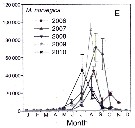 Issued from : K.E. Arendt, T. Juul-Pedersen, Mortensen J., M.E. Blicher & S. Rysgaard in J. Plankton Res., 2013, 35 (1). [p.115, Fig.7, E]. Issued from : K.E. Arendt, T. Juul-Pedersen, Mortensen J., M.E. Blicher & S. Rysgaard in J. Plankton Res., 2013, 35 (1). [p.115, Fig.7, E].
Abundance (ind. m3) ± standard deviation of the copepodite stage I-VI of Microsetella norvegica from 2005 to 2010 in SW Greenland near Nuuk.
Nota: Algorithm used to convert body length to body carbon: Equation (Carbon): Ln (µg C) = 1.7843 In (L µm) + In 11.14.
L= prosome length.
During summer, the increase in total copepod biomass was due to higher biomass in M. norvegica. The copepod biomass peaked in August at 71 ± 49 mg C m3; 59% of this was due to M. norvegica |
| | | | Loc: | | | Cosmopolite. Also: Antarctic (Drake Passage, Scotia Sea, SW Atlant., Indian, SW & SE Pacif.), Beagle Channel, South Georgia, sub-Antarct. (Kerguelen Is.SW Pacif.), Arctic (Alaska : Auke Bay, Fram Strait, Wyville Thomson Ridge, Spitsbergen, Kongsfjorden, Kara Sea, White Sea, Chupa Inlet, Barents Sea, Pechora Sea, Franz Josef Land, Nansen Basin, Amundsen Basin, Makarov Basin, Chukchi Sea, Canada Basin, Bering Sea, St. Lawrence Island, Nuuk, Greenland, Anadyr Strait, Newfoundland, Norway (Tromsø fjords), North Sea, Indian, Japan ( Kyushu: Shijiki Bay, Kuchinoerabu Is., Tokyo Bay, Yatsushiro-kai, Ariake Bay, Honshu: Maizuru Bay), W Hokkaido, Seto Inland Sea, China Seas (Bohai Sea, Yellow Sea, East China Sea, South China Sea), Perai River estuary (Penang), Straits of Malacca (Sangga estuary: mainly lower and nearshore, offshore) Malaysia (Sarawak: Bintulu coas, Tioman Is.t), Taiwan Strait, off SW Taiwan, Taiwan, G. of Thailand, Palau Is., Gulf of California, Chile (N-S, off Santiago), Caribbean Colombia (Darién), Suez Canal (Timsah Lake, Kabret, Km. 152), Sharm El-Sheikh, Hurghada, Safâga, Port Taufiq, Red Sea, Laccadives: Kavaratti & Agatti Is (offside & lagoon) | | | | N: | 328 | | | | Lg.: | | | (34) F: 0,5; M: 0,51; (35) [Atlant.N] F: 0,48; [N-Z] F: 0,4-0,36; (38) F: 0,57; (45) F: 0,5-0,4; M: 0,4-0,3; (46) F: 0,53-0,35; M: 0,42-0,33; (59) F: 0,57-0,35; M: 0,51-0,33; (66) F: 0,61-0,5; (109) F: 0,7-0,5; M: 0,66-0,5; (135) F: 0,53; (138) F: 0,57-0,35; M: 0,42-0,33; (208) F: 0,76; (246) F: 0,49; (449) F: 0,53-0,35; M: 0,42-0,33; (618) F: 0,57; (719) F: 0,53-0,35; M: 0,42-0,33; (786) F: 0,56-0,4; (991) F: 0,35-0,53; M: 0,33-0,42; {F: 0,35-0,76; M: 0,30-0,66} | | | | Rem.: | Epi-bathypelagic.
Sampling depth (Antarct., sub-Antarct.) : 0-600 m. 0-160 m (Pippe & Coombs, 1980 at 60°N, 07°W).13
Sometimes in brackish water (Chilka Lake in Sewell, 1924; Casamance estuary).
According to Yamazi (1958) the species is common in winter and spring in Tanabe Bay (Japan).
Evans & Diaz (1978, p.313) underline the direct relationship between the size and the temperature in the North Sea.
This form is well represented over the entire length of the Suez Canal.
Observed in ballasts of ships at San Francisco.
After Arendt & al. (2011, p.70) this species dominated the copepod community in the entrance to Godthabsfjord near Nuuk (SW Greenland) at 64°07'N, 51°53'W during 7 months out of a year and makes up > 50 % of the total abundance. However, abundances are low in January-April where M. norvegica make up 32-49 % of the total abundance. From June the abundance of M. norvegica increases rapidly and peaks in July with in average 159.1000 ± 56.000 ind./m3. Due to the massive abundance of M. norvegica it constitutes 95-86 % of total abundance in July-September, respectively, whereas the contribution of other copepods decreases in the same perod. In October M. norvegica numbers decreases to 150.000 ind/m3 until December.
After Benedetti & al. (2018, p.1, Fig.2) this species belonging to the functional group 5 corresponding to small sac-spawning detritivorous.
Ohtsuka & Nishida (2017, p.578) point to the Japanese coasts adjacent to the Kuroshio Current are distinguished by warm-water species M. norvegica.
See in DVP Conway & al., 2003 (version 1) | | | Last update : 25/10/2022 | |
|
|
 Any use of this site for a publication will be mentioned with the following reference : Any use of this site for a publication will be mentioned with the following reference :
Razouls C., Desreumaux N., Kouwenberg J. and de Bovée F., 2005-2025. - Biodiversity of Marine Planktonic Copepods (morphology, geographical distribution and biological data). Sorbonne University, CNRS. Available at http://copepodes.obs-banyuls.fr/en [Accessed November 03, 2025] © copyright 2005-2025 Sorbonne University, CNRS
|
|
 |
 |






















